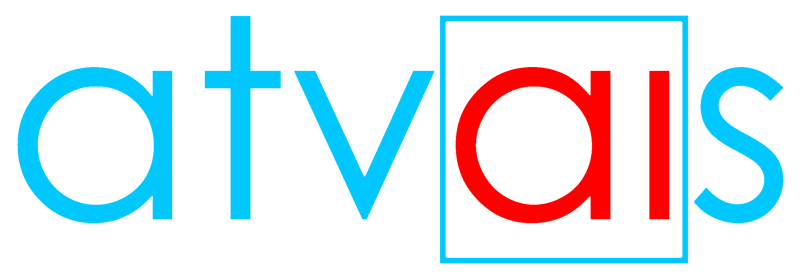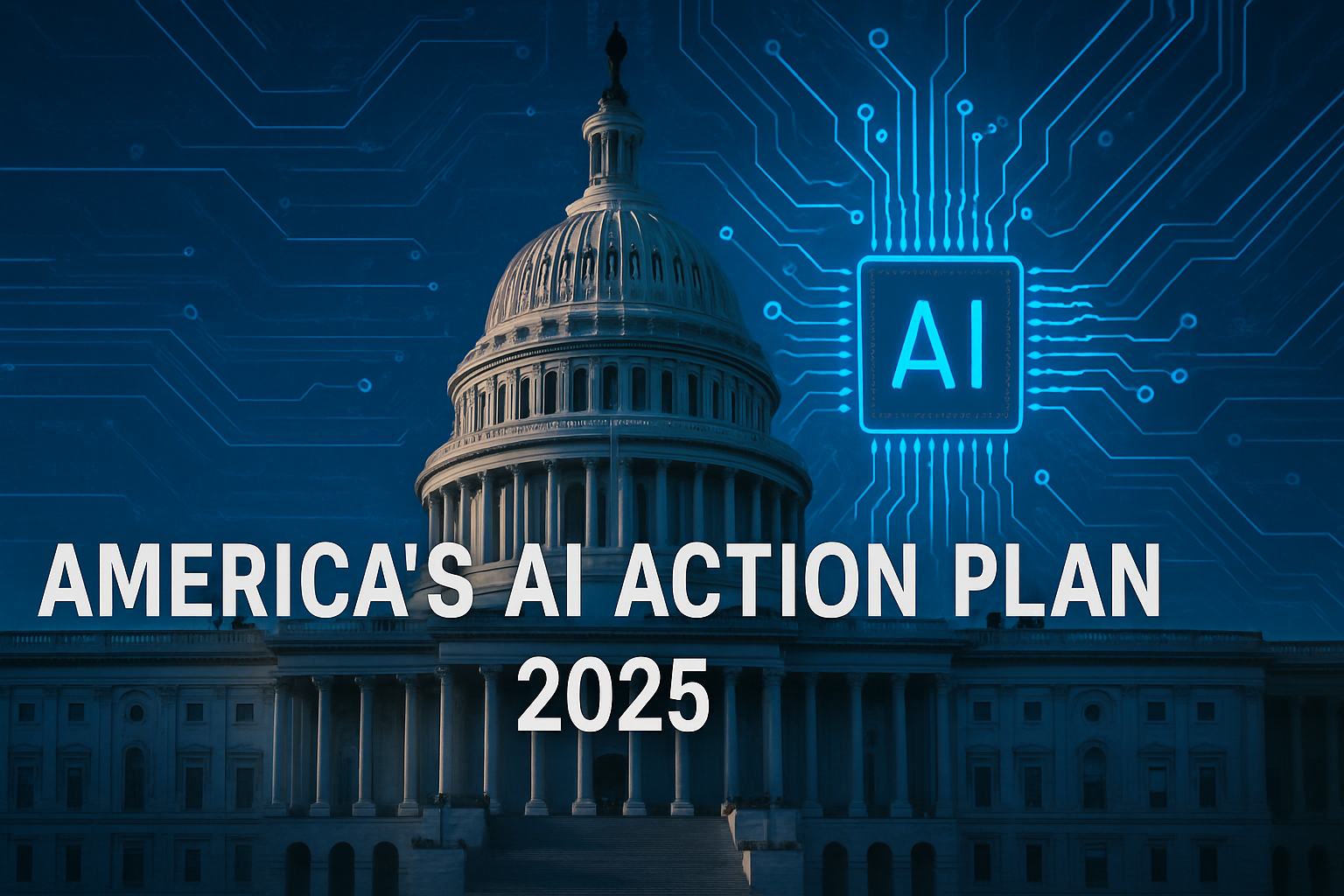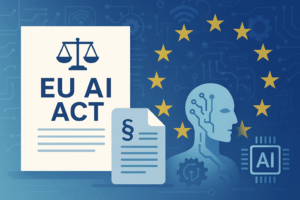This week brought one of the most consequential developments in global AI governance: the release of the Trump administration’s America’s AI Action Plan. Announced between July 23 and 24, 2025, the plan marks a dramatic shift in the United States’ approach to artificial intelligence, with significant implications for federal oversight, international competition, and the future role of public sector AI use.
While the UN’s AI for Good summit in Geneva focused on inclusive and ethical AI development, the U.S. announcement has dominated headlines. With sweeping regulatory reversals and bold new priorities, the Action Plan positions the United States on a deregulatory path intended to boost innovation, restrict ideological influence, and expand American AI power abroad.
Key Pillars of the AI Action Plan
At the core of the plan is a commitment to significantly reduce federal oversight of AI development. The administration argues that overregulation stifles innovation and slows down the deployment of advanced technologies. This stance aligns closely with calls from the U.S. technology sector to avoid the kind of heavy-handed legislation seen in the EU.
The government’s stated goal is to foster a climate in which developers can experiment, iterate, and scale with fewer compliance barriers. Agencies are instructed to review and eliminate existing rules that may “unnecessarily impede AI deployment,” particularly those involving risk assessment frameworks and impact reviews.
Executive Orders Against “Woke AI”
One of the more controversial elements of the plan is the signing of three executive orders targeting what the administration calls “ideological bias” in government AI systems. These orders mandate that any AI used in federal systems must be free of diversity, equity, and inclusion (DEI) principles.
The administration claims that AI outputs must remain neutral and fact-based. As a result, all federal agencies are now required to audit existing models and retrain systems where necessary to remove what are described as “partisan frameworks.” The move has been sharply criticized by civil rights groups, which argue that eliminating DEI from AI systems may reinforce structural inequalities.
New Federal Procurement Rules
The Action Plan also introduces new rules for government procurement of AI systems. Federal contracts will only be available to providers that can demonstrate their large language models are “objectively neutral” and “free of bias.” This creates a major compliance challenge, as the concept of bias in AI remains technically and philosophically contested.
Vendors must provide documented assurance that their systems meet these criteria. This could reshape the AI procurement landscape, favoring companies that adopt transparency mechanisms, model audits, and verification tools, while raising questions about enforcement and evaluation criteria.
AI Export and International Positioning
Another central pillar of the strategy is a push to make the United States a global leader in AI exports. The plan outlines several steps to streamline the export process for AI-related technologies, including hardware, software, and full-stack AI platforms.
This includes fast-tracking export permits, investing in data infrastructure, and forming bilateral agreements with allied countries. The government envisions American companies dominating international markets, especially in regions where local AI ecosystems are still emerging.
Federal Preemption of State AI Laws
In a further bid to centralize AI policy, the plan proposes withholding federal funding from states that introduce what are deemed “overly restrictive” AI regulations. The administration argues that a fragmented legal landscape impedes innovation and increases compliance costs for developers operating across state lines.
This approach would significantly reduce the ability of individual states to implement more cautious or rights-focused AI laws. Legal experts warn this could lead to constitutional challenges and tension between state and federal authorities.
Policy Reversal and International Context
The current strategy represents a clear reversal of the Biden administration’s approach to AI. Under President Biden, the focus had been on risk mitigation, responsible innovation, and strong export controls to prevent advanced U.S. AI from reaching authoritarian regimes.
In contrast, the new plan removes many of these safeguards. Export restrictions are relaxed, and public-private partnerships are encouraged to boost the development of advanced systems that can be exported to allies. This signals a shift from security-centered policy to market-driven priorities.
Reactions from Stakeholders
The plan has generated strong and divergent reactions.
Supporters, particularly within the tech industry and some economic policy circles, have welcomed the deregulatory thrust. They argue that loosening oversight will allow U.S. firms to maintain global leadership and accelerate innovation.
Critics include civil society groups, privacy advocates, labor unions, and several academic institutions. Their concerns focus on the absence of guardrails, the removal of equity principles, and the potential for harmful AI deployment without adequate accountability. Labor groups have also voiced fears that the new framework may overlook workforce impacts and displacement issues.
UN AI for Good Summit
While the U.S. announcement attracted the bulk of media attention, the UN held its annual AI for Good summit in Geneva earlier this month. The summit focused on ethical AI, global cooperation, and inclusive governance, stressing the need for international safeguards and community engagement.
Despite its relevance, the summit was largely overshadowed by the geopolitical weight of the U.S. Action Plan. This reflects the growing reality that domestic AI policy in large economies is beginning to set global norms, whether through trade, influence, or technological diffusion.
Implications for AI Governance
The America’s AI Action Plan marks a decisive moment in global AI policy. It signals a move toward a deregulatory, pro-export, and anti-ideological model of governance. Whether this model will lead to global adoption or greater fragmentation remains to be seen.
From a policy perspective, the shift presents several challenges:
- The definition and measurement of AI “bias” is not yet standardized, creating uncertainty for both vendors and regulators.
- The centralization of power at the federal level may lead to clashes with states that prioritize consumer protections.
- The sidelining of DEI and human rights frameworks may have long-term social consequences, particularly in public sector AI use.
- The international AI landscape is likely to polarize, with the U.S. favoring speed and scale, and Europe and others emphasizing risk and rights.
As global governance remains in flux, this development will likely shape bilateral cooperation, international trade policies, and the broader debate on the ethics and limits of artificial intelligence.
Conclusion
The America’s AI Action Plan is more than a national strategy. It is a declaration of values, a market signal, and a geopolitical move. By prioritizing innovation, competitiveness, and neutrality over regulation and oversight, the United States is setting a clear direction for its AI future.
Whether this trajectory leads to leadership or backlash will depend on how the plan is implemented, how industry actors respond, and how other countries position themselves in the evolving AI governance landscape. In the meantime, the world is watching, and the stakes could not be higher.






